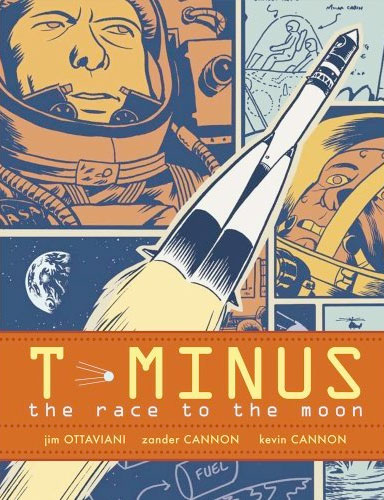|
|

|
|
Author
|
Topic: T-Minus: The Race to the Moon (graphic novel)
|
Robert Pearlman
Editor Posts: 42981
From: Houston, TX
Registered: Nov 1999
|
 posted 02-18-2009 01:41 PM
posted 02-18-2009 01:41 PM
   
Newsarama: The Race to the Moon in Comic Form: Ottaviani on T-Minus In 1969, man first set foot on the moon. In 2009, a new graphic novel will show readers what it took to get there.Jim Ottaviani's science-themed graphic novels have covered everything from fossils (Bone Sharps, Cowboys & Thunder Lizards) to the atomic bomb (Fallout), and now he's taking readers all the way to the moon and back. T-Minus, Ottaviani's new graphic novel from Simon & Schuster, tells the story of the 1960s space race from a perspective that's rarely been seen before., with art from Zander and Kevin Cannon. Ottaviani gave us the scoop on how his story is unique from other tales of the moon landing, and why this seminal event in human history remains important today. Newsarama asked Ottaviani how he went about his research for the graphic novel. It's almost impossible to answer that question. To give you an idea, let's take a look at the full bibliography for T-Minus...[thumbs through pages] let's see, with annotations the full bibliography runs eight pages. So I guess the correct answer is, "A lot!"The space race is a nice thing to work on because it's so well-documented. But there's a lot to research for any book - you want to get a feel for the times. You want to understand the social situation, the political situation - and have a lot of cool visuals for your artist to draw. For T-Minus we wanted to be careful about anachronisms - when it comes to the space race, there are a lot of people who are obsessive about this! I'm one of them. So we were extremely careful about getting things right visually. I'm sure there are some mistakes, because the story is complex, but at least they're not there because we couldn't be bothered to try and get it right! At the same time, there were things we had to do with the book that were not 100 percent accurate historically. For example, the total number of people who worked on the Apollo, Gemini and Mercury programs is estimated at around 400,000 people in the US. In a 128-page book, if you wanted to show them all you'd have to find a way to get about 3,000 people onto each page! So you have to composite some people, to help the story move along. But the goal is to keep the reader moving through the story, so they understand the facts and the details regarding how things went down. I should mention, I have 37 pages of script outtakes and scene descriptions we couldn't fit into the story. So maybe one day there'll be a director's cut of T-Minus that will be five times as long as this version! According to Amazon.com, T-Minus: The Race to the Moon will be released on May 19, 2009. will be released on May 19, 2009. |
E2M Lem Man
Member Posts: 846
From: Los Angeles CA. USA
Registered: Jan 2005
|
 posted 05-26-2009 10:26 PM
posted 05-26-2009 10:26 PM
   
A friend of mine brought this to my attention. It tells about the first space age from 1957 to 1969, with a couple of stops along the way to tell the reader about Jules Verne, Goddard, von Braun, etc.I had to laugh - it follows a North American Aviation engineer as he worked within NASA to help bring about the Moon Landings. There is a glossary and a bibliography page. They did their homework. It is excellent for your teens this summer - and you might like it too! | |
Contact Us | The Source for Space History & Artifacts
Copyright 2020 collectSPACE.com All rights reserved.

Ultimate Bulletin Board 5.47a
|
|

|
 advertisement advertisement

|












